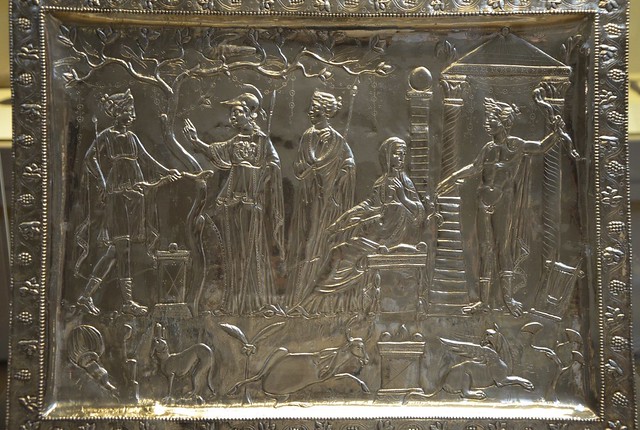The Corbridge Lanx, 4th century AD, from Corbridge, Northumberland, Roman Britain, British Museum

-
Description
A superlative late-Roman 'picture plate' designed for display This magnificent silver platter was found by nine-year old Isabel Cutter in the bank of the River Tyne at Corbridge, near Hadrian's Wall, in February 1735. It is probable that gradual erosion of the river bank was washing out part of a fourth-century silver hoard, as other vessels were found there on various occasions between 1731 and 1760. Corbridge (Coriosopitum) was a Roman garrison town. The scene shows the god Apollo at the entrance to a shrine, holding a bow, his lyre at his feet. His twin sister Artemis (Diana), the hunter goddess, enters from the left, and the helmeted goddess with her hand raised to indicate conversation is Athena (Minerva). The two female figures in the centre are less obvious. The entire scene is clearly a shrine of Apollo. The Greek island of Delos was the birthplace of Apollo and Artemis, and Athena was also worshipped there. If the Delian shrine is depicted then the older woman sitting spinning may be Leto, the mother of the twins, and the standing woman her sister Ortygia, who was transformed into the island of Delos. In the foreground stands an altar flanked by Artemis's hound and fallen stag and a griffin, a mythical beast associated with Apollo. The decoration of the platter and its style indicate a fourth-century AD date. Its place of manufacture is unknown but may have been a major city in the Mediterranean, North Africa or Asia Minor. Ephesos has been suggested because of its links with the cults of Artemis, Apollo and Leto. Though no other piece has survived, some were sketched or described when they were originally found. At least one of the lost objects bore Christian symbols. We can compare the treasure with the Mildenhall treasure where high-quality pagan decoration is combined with a few Christian references. The Latin term lanx (tray) was used for vessels of this shape by eighteenth-century scholars. T.W. Potter, Roman Britain, 2nd edition (London, The British Museum Press, 1997) -
Owner
Following Hadrian -
Source
Flickr (Flickr) -
License
What does this mean? Attribution-ShareAlike License
-
Further information
Link: https://www.flickr.com/photos/41523983@N08/15362738120/
Resource type: Image
Added by: Simon Cotterill
Last modified: 8 years, 5 months ago
Viewed: 1712 times
Picture Taken: Unknown -
Co-Curate tags







